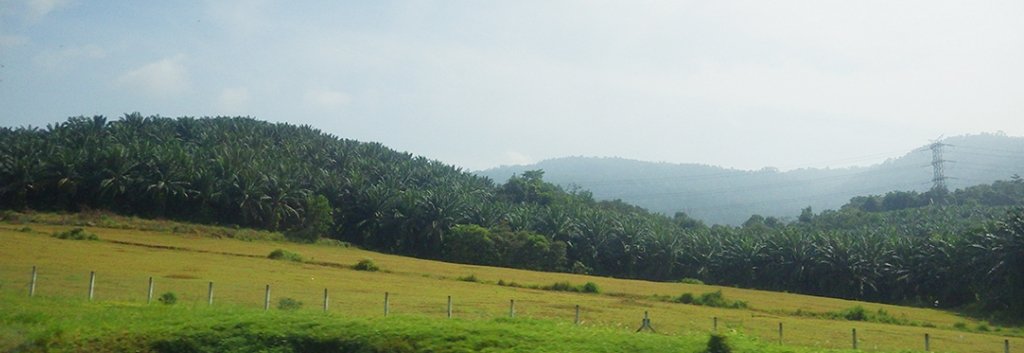Producing palm oil sustainably requires nations to learn from each other’s best practices. Erin Pischke explores impacts of the cash crop in her guest blog.
Have you eaten a candy bar recently? Or washed your hands with a bar of soap? Maybe you took a prescription drug or put non-dairy creamer in your coffee. If so, chances are you touched palm oil, which is a common ingredient in everyday products.
While palm oil is consumed around the world, oil palm trees, which produce a fruit that is cultivated as a source of oil, are grown only in tropical countries like Indonesia and Brazil. Indonesia’s and Malaysia’s production combined account for approximately 80 percent of global palm oil production. However, the area for oil palm tree plantation expansion in these countries is limited. Because of its tropical, humid climate and extensive land area, Latin America is a major new frontier for oil palm expansion, with countries such as Mexico and Peru exhibiting growth in the area of oil palm cultivation.

In Latin America, as in Southeast Asia, oil palm cultivation is expanding rapidly in a place fraught with colonial history, income inequality and biodiversity hotspots. The environmental impacts of growing industrial-scale oil palm are visible in the burnt forests of Southeast Asia, where orangutan habitat has been destroyed, carbon long stored in peatlands and soil has been released into the atmosphere and biodiversity is reduced or severely threatened.
While both regions have high rates of deforestation in some areas, Latin American plantations are often established by cutting, rather than burning the forests, which limits the negative health impacts endured by the workers, or established on former cattle ranches. However, the push to establish oil palm alongside these landscapes threatens regions’ last remaining forests — including the Amazon.
The negative social and environmental impacts are regularly studied in individual countries and regionally, but have yet to be compared across Southeast Asia and Latin America to assess what the stakeholders in each country can learn from one another’s experiences with the crop to improve environmental governance.
Collaborating Across Oceans
As a researcher who studies the public’s perceptions of palm oil production in Mexico, I was invited to participate in a workshop in June 2018 called “Environmental Governance in the Palm Oil Sector: Comparing Approaches in Southeast Asia and Latin America,” hosted by the Centre for Latin American Studies at the University of Malaya, Malaysia.
Researchers who study palm oil in Brazil, Honduras, Indonesia, Malaysia and the Philippines also participated. The three-day intensive workshop allowed researchers and academics from Southeast Asia to present their work, begin discussions on similarities — historical patterns of colonialism in the countries where oil palm is grown and international and domestic interest in expanding the crop’s acreage — and differences — government policies and governance of oil palm and sustainability and sustainable certification of the crop — across countries, as well as plan collaborative research.

While you have to almost go looking for oil palm plantations in Tabasco, Mexico, Malaysian oil palm, in contrast, is very prominent. Even after driving a short distant outside of the country’s capital, Kuala Lumpur, oil palm begins to appear alongside the highways. As in Tabasco, the hot, muggy weather that persists year-round in Malaysia promotes the plant’s growth. However, in Southeast Asia, the push to grow more and more oil palm in unused spaces is apparent in the huge swaths of land that are covered in the crop. From my recent trip to Malaysia, it was clear that oil palm is planted everywhere possible in the rapidly urbanizing country.
Many Latin American governments are promoting biofuel development from crops like oil palm as an alternative fossil fuel that could also stimulate rural development. In both Latin American and Southeast Asia, countries have had mixed success in managing the growth of oil palm. Various products can be produced from oil palm, but it is profitable only after the grower invests in the start-up costs, leaving many smallholder growers the only option of working on a large industrial plantation rather than establishing a large plantation of their own.
Oil palm cultivation can create conflict. Clearcutting and burning to make room for oil palm plantations and oil palm pushing out food crops, have caused environmental damage and social unrest.
Tradeoffs and Choices
In one of the communities where I conducted research on oil palm production in Mexico, individuals and small groups of people have established plots of oil palm that are much smaller than the industrial plantations. They often have other food or commodity crops intermingled with the oil palm trees and benefit directly from the sale of the fresh fruit. Such small-scale land use can be beneficial to the local environment because it can be contained to marginal land to help protect biodiversity, while beneficial to the economy through job creation and income generation in local communities.
However, the benefits may be outweighed by negative or unintended consequences if the crop causes indirect degradation of native habitat if, for example, food crops or cattle are moved to native forest to make room for the oil palm plantation. More land has to be devoted to shared space for multiple crops to get the same yield as a larger production system. These are some of the tradeoffs and challenges that face the industry; however, the methods that Latin American countries, like Mexico, are using can potentially produce more sustainable oil palm that Southeast Asian countries can learn from.
Climate change will exacerbate the challenges caused by environmental degradation such as deforestation. We need action on all levels of government to solve land-use challenges and we need collaboration between countries to exchange information about how best to grow and manage the oil palm crop.
We also have a choice when buying everyday items like shampoo or detergent. Not only are the local people who live in regions where oil palm is grown depending on responsible customers to make responsible choices, but the health and biodiversity of the planet are also inextricably linked to our purchases. Demanding certified sustainable products and being knowledgeable about products that are made with ingredients grown and sourced in an ethical and environmentally-responsible manner, can help keep forests in Indonesia or Brazil intact and carbon locked in the trees and soil.
Michigan Technological University is an R1 public research university founded in 1885 in Houghton, and is home to nearly 7,500 students from more than 60 countries around the world. Consistently ranked among the best universities in the country for return on investment, Michigan's flagship technological university offers more than 185 undergraduate and graduate degree programs in science and technology, engineering, computing, forestry, business, health professions, humanities, mathematics, social sciences, and the arts. The rural campus is situated just miles from Lake Superior in Michigan's Upper Peninsula, offering year-round opportunities for outdoor adventure.






Comments